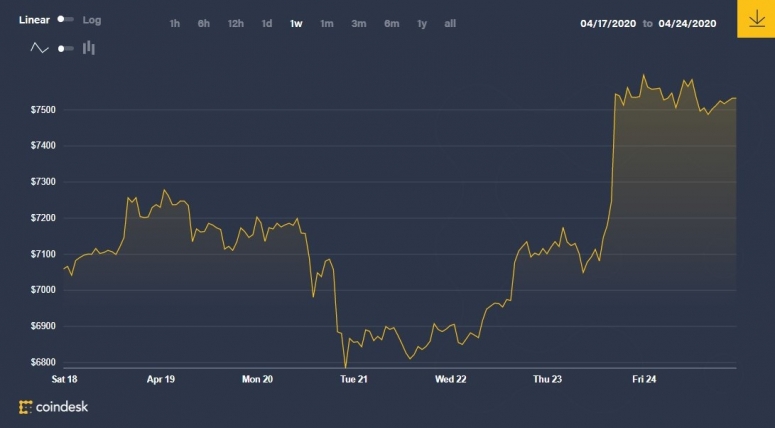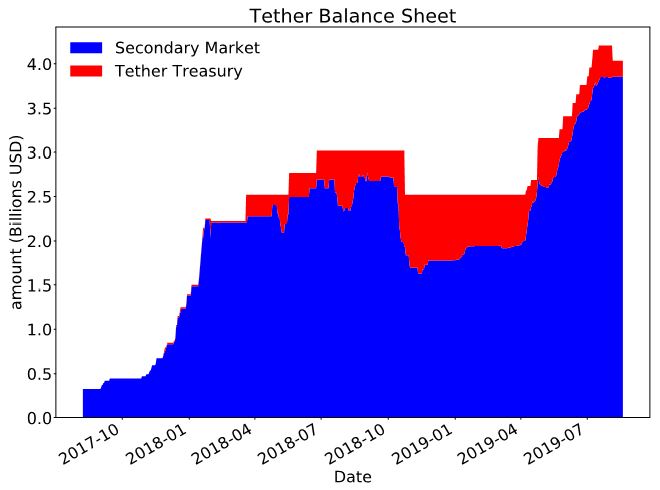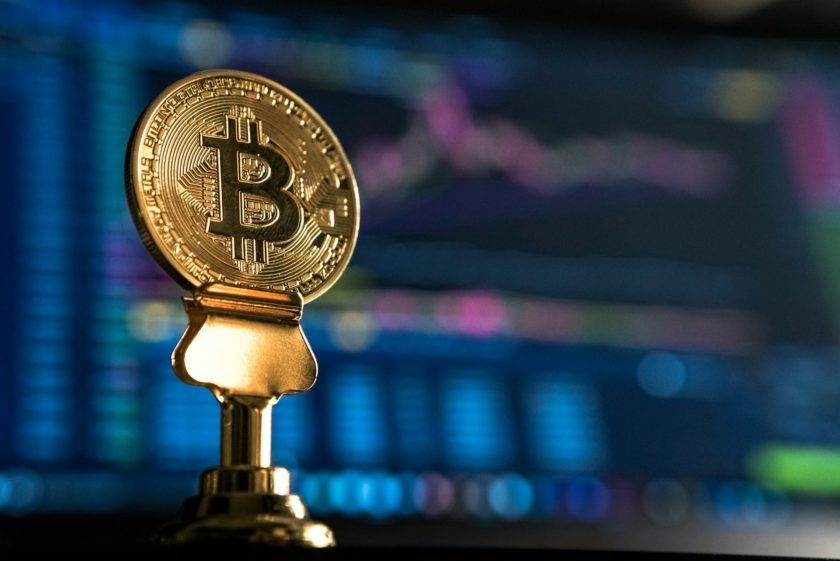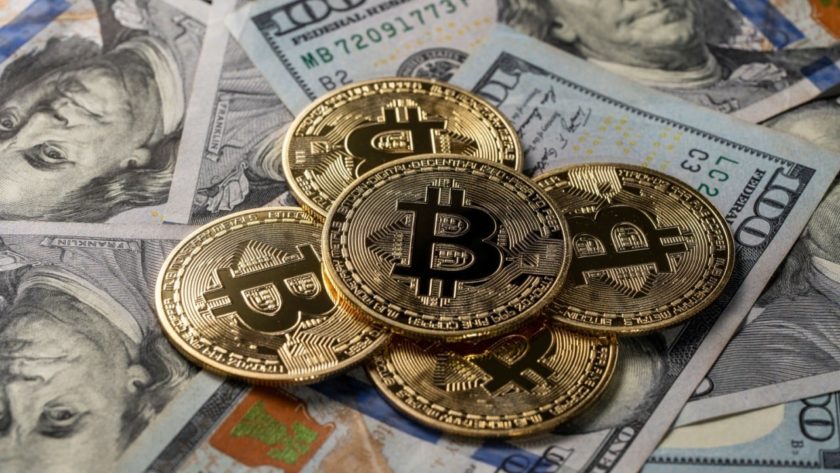This will always be remembered as the week when oil went negative.
The economic repercussions of this are staggering and will take months to fully comprehend – but, more short-term, one of the most fascinating aspects is how it knocks universally accepted truths about markets right into the oil can.
Also compelling is what this says about biases in the bitcoin market.
You’re reading Crypto Long & Short, a newsletter that looks closely at the forces driving cryptocurrency markets. Authored by CoinDesk’s head of research, Noelle Acheson, it goes out every Sunday and offers a recap of the week – with insights and analysis – from a professional investor’s point of view. You can subscribe here.
It turns out that commodity prices don’t have a floor. Who knew. To be fair, this is not the first time a commodity has traded below zero – natural gas prices have in the past gone negative as logistical problems make it hard to get to buyers, and many refineries see it as a waste byproduct of oil production. Outside the energy sector, dairy farmers across the U.S. are currently dumping excess milk rather than pay consumers to take it away.
What does this have to do with bitcoin? It sheds light on the nature of the asset itself, and on products built on top of it.
According to the CFTC and other regulators, bitcoin is a commodity. Technically, it falls into the category of financial commodities, which include currencies and indices. These do have a floor. They can go to zero, but not below – once at the minimum, they have neither a use nor a carry cost, so investors can write off their value and, after some gnashing of teeth, forget about them.
But what if a financial commodity’s value was based on an underlying commodity that traded at negative prices? USO is the largest ETF in the energy sector and holds near-dated WTI futures. This week those futures were trading below zero, since they involve physical delivery of oil that no one knows where to store. But the ETF is a financial commodity, and cannot trade below zero – therefore, it cannot reflect its underlying assets.
This week, USO scrambled to save its listing. It announced a reverse share split to push its price back above the Nasdaq minimum requirement, and it changed its investment strategy to focus on slightly longer-term futures. It also applied for authorization to issue more shares, since money is pouring in, reportedly from retail investors who hope to ride the recovery all the way up.
So, here you have an ETF whose value does not necessarily reflect the underlying asset, maneuvering to be able to sell more shares to retail investors in a dislocated market that is one of the most blatantly manipulated in the world. And yet bitcoin ETF proposals are rejected as being too risky, opaque and manipulable.
A bitcoin ETF would be based on a financial commodity that runs on a global network accessible to all. Most of the main exchanges have market surveillance, and improvements in market liquidity should enable the ETF price to closely track the market value of the underlying asset, giving investors reassuring clarity and transparency. The same cannot be said of the most liquid listed bitcoin-tracking instruments today*, which have lock-in periods during which investors cannot sell, and which trade at a significant premium to bitcoin. This is largely a result of the SEC’s reluctance to approve liquid and easily redeemable investment vehicles suitable for all types of investors.
Any change in SEC policy regarding bitcoin ETFs is unlikely in the short term, as there are no current proposals under consideration. But the disconnect between the reasons given for rejection, and the glaringly public characteristics of many approved ETFs that also don’t meet the quoted criteria, could encourage the regulator to overcome its instinctive reluctance.
(*one of these is GBTC, managed by Grayscale Investments, which is owned by CoinDesk’s parent DCG.)
Anyone know what’s going on yet?
There is no such thing as a boring week in the crypto asset sector (unfortunately – a boring week would be nice every now and then), but this week was particularly intense, with the price ranging 12% from low to high (data from the CoinDesk BPI).
According to my colleague Zack Voell, the sharp jump upwards may have been motivated by the futures expiry on Friday, as well as by investor sentiment primed for a move after the recent consolidation. And maybe – just maybe – it has something to do with mounting excitement over the upcoming Bitcoin halving, expected in just over two weeks. (Download our recent report on the Bitcoin halving for analysis of its potential impact.)
In the news, new crypto asset products keep flowing thick and fast, while increasing attention is being paid to enterprise applications including the handling of data in a post-COVID world as well as central bank digital currencies. And DeFi continues its process of growing up.
Outside the crypto space, things are getting even weirder as disinfectant manufacturers plead with us to not inject their products, and traders eye their bathtubs and kitchen pots for possible oil storage. Tensions are rising in Europe as Italy, the EU’s third largest economy, has been pity-spared a drop to junk bond status. Asian markets are dealing with the suspense over Kim Jong-Un’s health and the unrelated threat of a second wave of contagion. Markets are reeling between relief that things aren’t even worse, and fear that they will be, with a dose of denial thrown in.
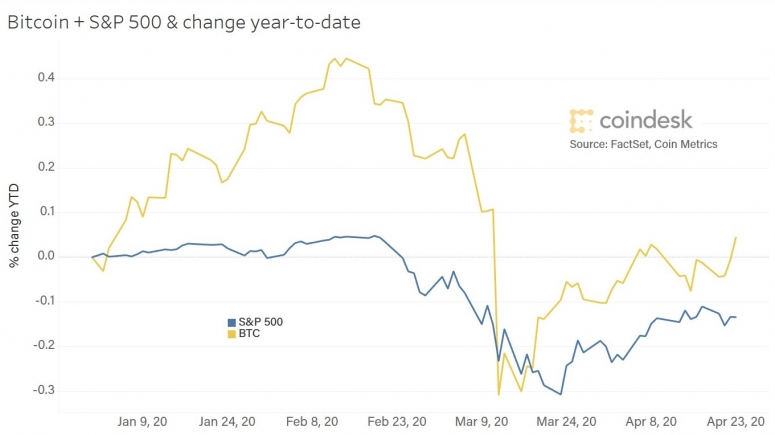
Bitcoin has outperformed the S&P 500 so far this week, month and year-to-date, although gold and long-term government bonds have done significantly better so far this year.
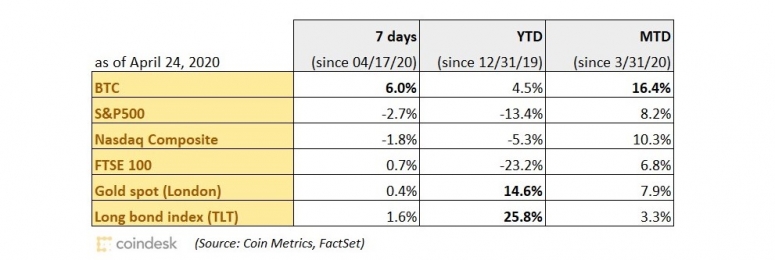
Next week will see a slew of economic indicators that will most likely be shockingly awful, but this week the futures actually went up on the news that more than 4 million people applied for benefits, because it seems that confirmation of bad news is somewhat reassuring. You do have to wonder when the penny will drop that indices suspended from reality don’t stay afloat forever. On the other hand, some economies are tentatively eyeing a re-opening of some sort, which will bring a welcome if tentative respite to restive animal spirits.
CHAIN LINKS
The Economist magazine dives into the options available to governments trying to figure out how to guide their economies out of this crisis. The options, none of which look good, include following the “financial repression” policies of the post-war economies of the previous century, which could take the form of capital controls, fixed exchange rates, rationed bank lending and caps on interest rates. It acknowledges that such changes would be “politically demanding,” but that these are politically demanding times. “But if governments did enact such changes,” it goes on, “they would spur responses unavailable to investors of the 1950s and 1960s, such as investment in cryptocurrencies and other immaterial products.” TAKEAWAY: Exactly. The modern economy has gone through hardship before that required ideological sacrifices, but not at a time when there were alternatives to central bank currencies, and not at a time when it was possible to move wealth without using the established system. Does that make governments weaker at the expense of empowered citizens? Or could the governments use cryptocurrencies to become empowered themselves?
I’ve mentioned in this newsletter before that I worry about a sustained uptick in inflation once we have emerged from the worst of this crisis, and how that could be good for bitcoin’s value given its limited supply. But what if I’m wrong and we enter a world of deflation, does that mean bitcoin will underperform? Not necessarily. The resulting boost in its purchasing power and its parallels to gold, which has traditionally done well in times of deflation, could give it fuel to outperform. TAKEAWAY: Bitcoin was born during the last financial crisis, so its reactions and correlations have not been tested. We do not know under which scenario it will perform best, and economic theory can justify swings either way.
Crypto asset platform Coinbase describes the current stablecoin landscape, with a focus on use cases. TAKEAWAY: The power of stablecoins to encourage liquidity, facilitate transactions and act as collateral is just beginning to be understood. The growth this year is likely to continue to be staggering, driven largely by both transaction demand and a surging global demand for dollars, of which stablecoins are a relatively convenient and liquid representation. (For more on this topic, see Michael Casey’s newsletter, “Money Reimagined,” from last week.)
A research paper funded by University of California Berkeley’s Haas Blockchain Initiative concludes that stablecoin issuances do not push up the price of cryptocurrencies. TAKEAWAY: This contradicts a controversial paper from last year that aimed to prove that tether manipulated the bitcoin market. The new paper separates tether in circulation from tether held in treasury, and shows that the stablecoin’s premium to the dollar depends largely on the market volatility.
More nuance on the news that broke last week that Renaissance Technologies has submitted regulatory filings that show that its flagship fund Medallion can invest in bitcoin derivatives – as we hinted last week, it’s not as bullish as the media initially painted it. TAKEAWAY: My colleague Ian Allison asked several industry insiders for their take on the news: all agree that Renaissance is not necessarily going “long bitcoin.” The story and the potential are not what drives their decisions, those are based on algorithmically generated numbers.
Starbucks and McDonald’s are reportedly among 19 restaurants and retail shops that will be involved in testing China’s central bank digital currency in the country’s Xiong’An new district. TAKEAWAY: Why is this potentially relevant for portfolios? Because mandated change is usually more powerful in overcoming resistance to new habits than the pull of innovation on its own. A national digital currency would get people comfortable with the idea of digital wallets, for instance, and from there it’s a relatively short step to incorporating other tokens and services. This is potentially significant because of its indirect relevance to the adoption of crypto assets in one of the largest economies, in which almost 1 billion people have a smartphone.
Wolfie Zhao walks us through changes to the Bitcoin mining industry in China over the past year, going into the impact of the coronavirus, how the March crash shifted sentiment, and the outlook for the new machines hitting the market. TAKEAWAY: As we talked about in our Halving Report, the Bitcoin mining industry is not only fascinating, it’s fundamental for the health of the network. Shifts in technology, economic conditions and political environment determine profitability which in turn impacts the protocol’s resilience. For more on this intriguing sector, at the intersection between business priorities, technological innovation and ideology, check out Christine Kim’s podcast series on miner economics.
The CFTC has given crypto startup Bitnomial Exchange approval to offer physically settled futures and options contracts. TAKEAWAY: Not that long ago a lot of us got excited about the pending launch of physically delivered derivatives on Bakkt, which ended up having a disappointing launch and an even more disappointing trading record. Bitnomial’s fee and margin structure might end up being more attractive to investors and traders, but, unlike Bakkt, for now it lacks the blue-chip backing of a market incumbent.
Crypto asset and blockchain data provider Amberdata lays out a detailed explanation of the stock-to-flow (S2F) model that predicts a bitcoin price of $100,000 by the middle of 2021. TAKEAWAY: The S2F model has adherents and skeptics – it seems to hold historically, but that’s not generally a good basis for forward investing, especially in these strange times. Check out our Halving Report for a look at some competing theses. The bottom line is that the bitcoin market is so different now than during the previous halvings, that no one knows what features or developments will carry more weight in price impact.
Vishal Shah, founder of bitcoin derivatives exchange Alpha5, points out that, with 100x leverage available on some exchanges with relatively light oversight, bitcoin won’t interest “traditional” capital, especially in these uncertain times. TAKEAWAY: It’s unlikely that 100x leverage is actually used by most traders, however – the few brave souls that do so are likely to get wiped out pretty soon, leaving the more sensible traders who push the boat out to maybe 35x, if that. “100x leverage” is more a worrisome marketing gimmick than a wealth accumulation strategy.
Security token platform Openfinance has asked its users for revised terms to defray costs, in a bid to avoid having to suspend trading. TAKEAWAY: After intensifying in 2018, interest in security tokens has been muted over the past year or so, as investor demand failed to materialize and contract frictions set back some high-profile projects. This development is an extension of the dampened enthusiasm, but should not be taken to mean that the concept has no merit. It’s early, the advantages so far have not been enough to overcome inertia and the fact that traditional markets are more liquid and have greater regulatory assurances. Given the recent market stress exposing a range of fault lines, though, we might – once things start to settle down a bit – start to see a renewed interest in an alternative capital markets system.
Disclosure Read More
The leader in blockchain news, CoinDesk is a media outlet that strives for the highest journalistic standards and abides by a strict set of editorial policies. CoinDesk is an independent operating subsidiary of Digital Currency Group, which invests in cryptocurrencies and blockchain startups.


